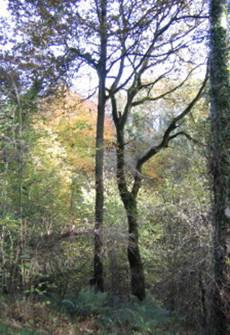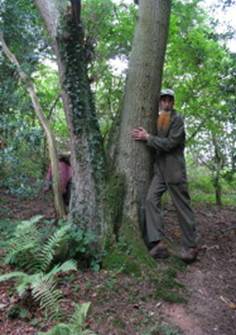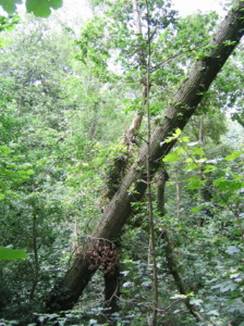

 |
The Art of Natural Forest Practice |
 |
CROESO>>> |
|
 |
 |
Why have some oak trees multiple stems and others single? Careful observation of the flora, and inparticular the trees, can reveal hidden dimensions of the history of your woodland. It’s as if the forest were trying to speak to us, tell us why it is as it is now and it’s too complex for us to comprehend adequately. ¬ For example, my woodland (CNG) has both single and multiple stem oaks. So what is the significance? They are all Sessile oak (Quercus petraea), but, I am assured by the forester, of mixed genetic origin, local and imported, a common feature in much of Britain. They vary from straight trunks to really bendy and everything in between. Some are single-stem from acorns, others multiple from the stumps of felled trees. The multi-stem are generally straight and the base larger, indicating they must be older. One in particular may be 400 years or more (illustration), whereas the single-stem are probably 100 years or less. * We know that the trees of timber quality were all felled in 1919, from which event the multi-stem oaks originate. The single-stem oaks must have seeded about that time, or were too small to be worth felling. * Following a management thin of the trees a decade or so ago, the gaps in the canopy thus created closed over. A gale caught some of the single-stem oaks, the roots proved inadequate to support the enlarged canopy and they blew over, whereas the multiple-stem oaks stood firm. * Historically, when the woodland was a productive part of the local economy, there must have been some fine oak trees, for there are none now big enough to replace the church roof were this necessary. * Thus past, present and future are living as one. Whatever we do, or do not do, will be evident for centuries to come. So what happened to the oak of the ancient woodland that new acorns were imported? * All hand-books on germinating trees state that oak is grown from acorns. It does not grow from cuttings to make a true copy, except I’m told, under laboratory conditions. As I’d like to reinstate the origianl genetic oak - if you can assist please contact me.
|
Above left– the two types of Sessile oak clearly visible, one straight that is of predominantly imported stock, the other bendy of largely local origin. Both germinated from acorns that are a cross pollination of these two sources, hence the diversity. |
 |